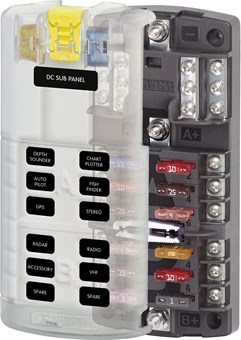Blue Sea Fuse Block Fundamentals Explained
Wiki Article
Getting My Blue Sea Fuse Block To Work
Table of ContentsA Biased View of Blue Sea Fuse BlockWhat Does Blue Sea Fuse Block Do?Some Known Factual Statements About Blue Sea Fuse Block Things about Blue Sea Fuse Block8 Easy Facts About Blue Sea Fuse Block Explained
If the current exceeds the AIC degree, the device may arc across or create a few other conductive path, as well as fall short to do its work. The ABYC calls for a/c and DC circuit breakers to have a minimal AIC score of 3,000 amps in many circumstances, and 5,000 amps in some.These are extensively offered and not that costly. The current-carrying capacity of conductors is offered in different tables. These are utilized to establish the optimum breaker or fuse rating (you can always go lower). In the American Watercraft & Luxury Yacht Council (ABYC) table, for a provided conductor dimension (e.


Fascination About Blue Sea Fuse Block
g., 00, generally created as 2/0, or 000, composed as 3/0, and also so on). The European system merely determines the diameter, or cross-sectional area, of the copper in a conductor as well as uses that. Not just are united state cable television dimensions counterproductive, yet there are likewise 2 various conductor-sizing formulas making use of the very same numbering system.

To handle this situation, the greater the variety of conductors in a bundle, the extra the current-carrying capacity (ampacity) of the private conductors is de-rated. This is done by applying a de-rating variable. Till lately the ABYC used this de-rating of bundled conductors only to circuits lugging more than 60V, which in functional boating applications indicates air conditioner circuits, however the ABYC now also partly uses de-rating to DC circuits.
Not known Facts About Blue Sea Fuse Block
You can locate a PDF variation of these tables and also an explanation on exactly how to use them here. A curled shore-power cable being in the sun is one circumstances not covered by packing as well as various other policies for which a cable should still be derated as a result of heat. The mixed effects of the coiling (basically, a type of bundling) and also solar home heating can effectively derate a shore-power cord by as long as 50%.A more conductor must be derated whenever there is any kind of obstruction to dissipating the warmth generated within it. Finally, note that most cabling utilized in U.S.-built watercrafts has an insulation temperature level score of 105C/221F, as opposed to the 90C/194F and even 60C/140F cabling found in many European-built boats. The insulation temperature level score should be printed on the cable, and also if it is not, the cord does not adhere to ABYC criteria.
As kept in mind above, in some circumstances a lower conductor insulation score may be picked. If any kind of part of the circuit being secured is inside an engineroom, the Inside Engine Spaces sub-column is used to determine the maximum permitted OCP, yet or else, the Outside Engine Spaces sub-column matters (blue sea fuse block). If the conductor is in a package, use the appropriate de-rating factor based upon the variety of conductors in that bundle.
8 Easy Facts About Blue Sea Fuse Block Described
If there is no exact match between the resulting see this page conductor ampacity and also available fuse or breaker rankings, the ABYC criteria allow the following greatest ranked fuse or breaker to be made use of on all yet main distribution panel fuses and breakers (these can not exceed 100% of the circuit ranking), as long as the fuse or breaker's ranking does not surpass 150% of the ampacity of the conductor it is shielding.Breaker need to match the ampacity of the cables they are safeguarding! Identify whether a fuse or a circuit breaker is a lot more appropriate for the task. Establish the ampacity of the tiniest conductor to be safeguarded by the overcurrent tool. Figure out the maximum continual present that link will stream on the circuit.
Often, particularly with bilge pumps, there is a lengthy run of partially sized electrical wiring to the electric motor (blue sea fuse block). If a locked-rotor condition creates, the overall resistance in the circuit might be adequate to restrict the present circulation to a level that will not trip the breaker or blow the fuse but which nonetheless is high enough gradually to begin a fire at the pump.
The Main Principles Of Blue Sea Fuse Block
The conductor size should be increased to make sure that the voltage drop on the circuit is decreased to a level at which adequate existing to trip the breaker or blow the fuse can stream. Nevertheless, the ABYC requires that all motors and also motor circuits be designed as well as secured to make sure that they can endure a locked-rotor condition for seven hours without producing a fire risk.Reasonably inexpensive and portable breakers rated at up to 150 amps are now commonly readily available, with each other with economical, compact fuses up to 800 amps. Common amperage ratings for typical marine fuse types.
The neatest way to deal with them, and also supply the required overcurrent protection, is to run a single hefty conductor, usually 2/0 gauge (70mm), from the favorable article on the home batteries to a battery-isolation switch. This conductor should be properly integrated as near to the battery as feasible. If the conductor is bolted (as opposed to secured) to the battery message, there are purpose-built integrates that can be included at the battery message itself (MRBF fuses).
Report this wiki page